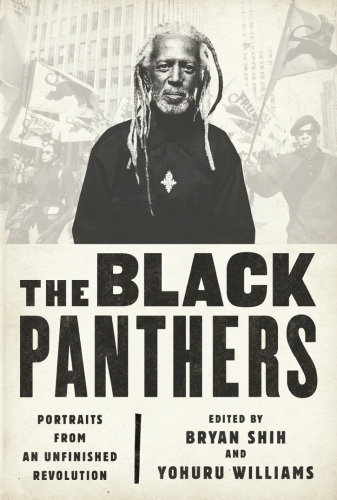
The Black Panthers
Portraits from an Unfinished Revolution
کتاب های مرتبط
- اطلاعات
- نقد و بررسی
- دیدگاه کاربران
نقد و بررسی

July 18, 2016
With a splendid assemblage of pictures and interviews, photographer Shih and historian Williams shine fresh light on the people in and the diverse activities of the Black Panther Party (BPP) on the 50th anniversary of its founding. Shih’s photographs of the 45 interviewees have the vibrancy and immediacy of treasured family portraits. The interviewees’ compelling recollections are buttressed by succinct but substantive essays from other contributors, including Alondra Nelson and Rhonda Y. Williams. Though iconic figures (Eldridge Cleaver, Huey Newton, Bobby Seale) haunt the book, the voices here are those of little-known grassroots members. Five broad themes organize the work: BPP history from its California roots to its spread through American cities; BPP’s impact on other movements throughout the world and in the U.S.; the role of women in the group; BPP’s free community services, such as neighborhood health clinics and give-away breakfasts; and Cointelpro, the FBI’s secret campaign against the BPP and other radical organizations. Appendices include the “Panther Ten-Point Platform and Program” and a dismaying selection of Cointelpro documents. The special virtue of this book is as bottom-up, rather than top-down, history—an illuminating view of the everyday aspects of “one of the most misunderstood organizations of the 20th century.”

July 15, 2016
An anthology commemorating the 50th anniversary of the Black Panthers focusing on the ordinary lives of its members.The Panthers' fungible reputation still affects American race relations. Co-editors Shih, a photojournalist and former contributor to the Financial Times, and Williams (Dean, Arts and Sciences/Fairfield Univ.; Teaching U.S. History: Beyond the Textbook, 2008, etc.) note their project was inspired by Shih's portraits of Panther members, which "demystify the group and present its former members as they are today." They divide the book into five sections to examine members' routes into the group, its strengths in coalition building and community action, and the violent counter-reaction by the government. These are developed into a fuller narrative via several essays by other scholars such as Peniel E. Joseph, who connects the Panthers' famous leadership to the outlook of their lesser-known followers: "Like many young black men of their generation...[Huey] Newton and [Bobby] Seale chafed against institutional racism, inadequate education, and police brutality." Many interviews capture a similar sense of youthful outrage; as a Japanese-American Panther notes, "we weren't any different in the way the larger society was treating us." Some contributors address the slippery nature of the Panthers' story, which tends to simplify their radical politics and sensationalize leaders' demands for armed self-defense. As Jama Lazerow explains, "a series of problems frustrates any attempt to accurately characterize the rank and file of the Black Panther Party." Interviewees acknowledge less romantic aspects of the movement, such as its eventual violent fracturing, which they insist was fomented by the FBI. Such flaws are contrasted with overlooked initiatives such as food pantries and medical care; as Alondra Nelson argues, they "placed these matters in the context of their broader political strategy." The surviving radicals regard their Panther years as formative; many went on to careers in social services or even government. An interesting celebration of a unique era's activism, with greatest appeal to progressive readers.
COPYRIGHT(2016) Kirkus Reviews, ALL RIGHTS RESERVED.

July 1, 2016
While most histories of the Black Panther Party (founded in 1966) focus on leaders such as Huey Newton, Bobby Seale, and Eldridge Cleaver; the tragic deaths of Bobby Hutton and Fred Hampton; and the counterintelligence programs the FBI ran to destabilize the organization, this collection uses interviews with rank-and-file party members to reflect what happened on a daily basis. Instead of depicting the armed inner-city soldiers commonly portrayed in the media, photojournalist Shih and historian Williams (history, Fairfield Univ.; Black Politics/White Power) focus on how the Panthers created health clinics, offered free breakfast for childrens' programs, and provided transportation for family and friends of inmates, among other civic actions. The book also covers the important role women played in the organization. Included are portraits of surviving members and short essays from leading scholars that give context to the interviews. VERDICT This highly recommended compilation of interviews and photographs of the Black Panther Party helps reframe its legacy to include the humanitarian work they performed across the United States. Readers interested in the current Black Lives Matter movement will find resonance in the Panthers' stories.--John Rodzvilla, Emerson Coll., Boston
Copyright 2016 Library Journal, LLC Used with permission.

Starred review from August 1, 2016
Inspired by Malcolm X and Stokely Carmichael and founded in Oakland in 1966 by college students Huey Newton and Bobby Seale, the Black Panther Party for Self-Defense established chapters across the country and around the world. Fifty years later, photojournalist Shih and historian Williams observe that the party remains one of the most misunderstood organizations of the twentieth century. To dispel this fog, they met with 45 surviving rank-and-file members, men and women who went on to become teachers, professors, attorneys, elected officials, founders and directors of not-for-profit organizations, and artists. Each is present here in striking photographic portraits and revelatory oral histories. As they share their hidden stories, the essential roles women played become clear, as do the rigor of the training and the demands of their social activism, from publishing a newspaper to opening schools, feeding the hungry, and providing health and legal assistance. They also recount violent police raids; vicious FBI harassment; the imprisonment, death, and exile of leaders; and the party's traumatic self-destruction. Incisive essays provide a larger historical context. Charlotte Mama C O'Neal reflects, It was a modern Underground Railroad. Brian Hunter says, The party helped me develop into a man of morals and principles. The Black Panthers' guiding principle, Jamal Joseph explains, was an undying love for the people. (Reprinted with permission of Booklist, copyright 2016, American Library Association.)

























دیدگاه کاربران